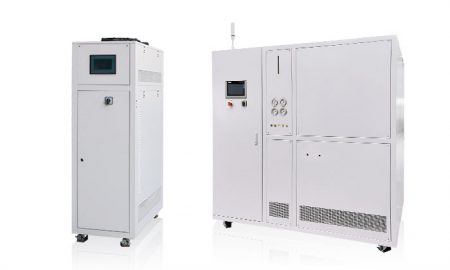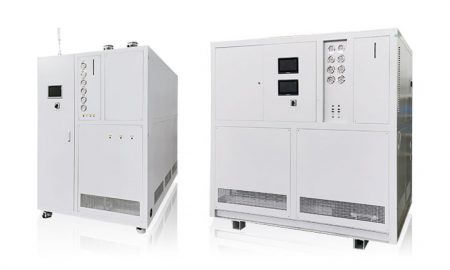Battery Cooling System for Electric Vehicle
Contacte-nos hoje para obter a solução perfeita de controlo da temperatura
The battery cooling system for electric vehicles is a critical component used to maintain battery temperature, improve performance and extend battery life. The battery cooling system removes heat from the battery module or battery stack and dissipates it to the external environment by circulating cooling liquid or heat transfer liquid. The following is a basic introduction to battery cooling system:
Working principle of battery cooling system:
The working principle of the battery cooling system is to remove the heat from the battery through circulating liquid, and then dissipate the heat to the surrounding environment through a radiator or cooling device. Typical work steps are as follows:
1. Liquid coolant flows into the battery: The liquid coolant enters the battery module or battery stack through the pipeline.
2. Absorb heat: When the liquid coolant flows through the battery module, it absorbs the heat generated in the battery.
3. Cooling liquid flows back: The heated liquid refrigerant flows back to the liquid cooling system, taking away the heat.
4. Heat dissipation: The cooling liquid passes through the radiator or cooling equipment and dissipates heat to the external environment. This can be achieved through air cooling or additional circulation in a liquid cooling system.
5. Circulation: The cooling liquid is circulated back to the battery, continuing to absorb heat and keep the temperature of the battery within a safe range.

Advantages of battery cooling system:
Battery cooling systems have some significant advantages in energy storage battery systems, including:
1. Thermal management: The battery cooling system can more accurately manage the temperature of the battery to ensure that it is within the appropriate operating temperature range, improving performance and life.
2. High-power applications: The battery cooling system is suitable for high-power applications and can quickly and effectively cool the battery.
3. Energy saving: battery cooling system can reduce cooling energy consumption and improve energy utilization efficiency.
4. Reduce thermal stress: By cooling the battery evenly, the battery cooling system can reduce thermal stress and extend the life of the battery.
5. Flexibility: The battery cooling system is suitable for various battery configurations and application scenarios, providing more flexibility.
Battery cooling system is an important part of battery technology, helping to improve the performance and reliability of battery systems and reduce operating costs. These systems often require careful design and maintenance to ensure they function properly.\
Correio eletrónico: info@lneya.com ID WeChat: +8615251628237 WhatsApp: +86 17851209193

Sistemas de controlo de temperatura e caudal para aquecimento/arrefecimento
Simulação da temperatura para o ensaio da qualidade do veículo: ensaio da duração da bateria, banco de ensaio do injetor/motor de combustível, ensaio do airbag, banco de ensaio de componentes, etc.
| Faixa de temperatura | -25°C ~ +100°C | -40°C ~ +100°C | 0°C ~ +100°C | -40°C ~ +135°C | |||||
| Capacidade de arrefecimento | 2,8 ~ 38kW | 1,2 ~ 60kW | 1,8 ~ 60kW | 4 ~ 60kW | |||||
| Nota: Qualquer faixa de temperatura de -150 ℃ ~ +350 ℃ e qualquer capacidade de resfriamento pode ser personalizada | |||||||||
A temperatura / pressão / caudal podem ser controlados de forma independente
1&2: uma máquina para o controlo de dois grupos
| Faixa de temperatura | -40 ~ +100℃ 1&2 | 0 ~ +100℃ 1&2 | |||||||
| Capacidade de arrefecimento | 1,8kW*2 ~ 60kW*2 | 1,8kW*2 ~ 60kW*2 | |||||||
| Nota: Qualquer faixa de temperatura de -150 ℃ ~ +350 ℃ e qualquer capacidade de resfriamento pode ser personalizada | |||||||||
A temperatura mantém-se constante, a pressão / caudal podem ser controlados de forma independente
1&3: uma máquina para controlo de três grupos
1&6: uma máquina para controlo de seis grupos
| Faixa de temperatura | -40 ~ +100℃ 1&2 | -40 ~ +100℃ 1&3 | -40 ~ +100℃ 1&6 | -20 ~ +100℃ 1&6 | 0 ~ +100℃ 1&2 | 0 ~ +100℃ 1&3 | 0 ~ +100℃ 1&6 | ||
| Capacidade de arrefecimento | 2,5 ~ 60kW | 4 ~ 60kW | 10 ~ 60kW | 10 ~ 60kW | 7 ~ 60kW | 11 ~ 60kW | 18 ~ 60kW | ||
| Nota: Qualquer faixa de temperatura de -150 ℃ ~ +350 ℃ e qualquer capacidade de resfriamento pode ser personalizada | |||||||||

Refrigeradores de óleo
Simulação da temperatura para o ensaio da qualidade do veículo: ensaio da duração da bateria, banco de ensaio do injetor/motor de combustível, ensaio do airbag, banco de ensaio de componentes, etc.
| Faixa de temperatura | 0℃ ~ +160℃ | +5℃ ~ +135℃ | |||||||
| Capacidade de arrefecimento | 11 ~ 60kW | 15 ~ 38kW | |||||||
| Nota: Qualquer faixa de temperatura de -150 ℃ ~ +350 ℃ e qualquer capacidade de resfriamento pode ser personalizada | |||||||||

Sistemas de arrefecimento e aquecimento para bomba eletrónica
| Faixa de temperatura | -40°C ~ +135°C | ||||||||
| Capacidade de arrefecimento | até 60kW | ||||||||
| Nota: Qualquer faixa de temperatura de -150 ℃ ~ +350 ℃ e qualquer capacidade de resfriamento pode ser personalizada | |||||||||

Câmara de teste de bateria com temperatura alta e baixa
| Faixa de temperatura | -40℃ ~ +100℃ | -40℃ ~ +100℃ | |||||||
| Capacidade de arrefecimento | 1,8 ~ 7,5kW | 4 ~ 15kW | |||||||
| Nota: Qualquer faixa de temperatura de -150 ℃ ~ +350 ℃ e qualquer capacidade de resfriamento pode ser personalizada | |||||||||

Sistemas de arrefecimento ou aquecimento direto para automóveis
| Tipos | Arrefecimento direto | Arrefecimento e aquecimento directos | |||||||
| Capacidade de arrefecimento | 5 ~ 10kW | 5 ~ 10kW | |||||||
| Nota: Qualquer faixa de temperatura de -150 ℃ ~ +350 ℃ e qualquer capacidade de resfriamento pode ser personalizada | |||||||||
 LNEYA
LNEYA
 简体中文
简体中文


















































































